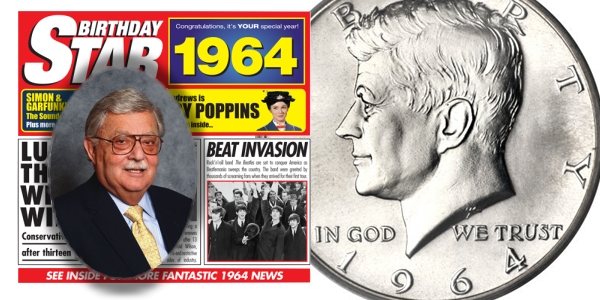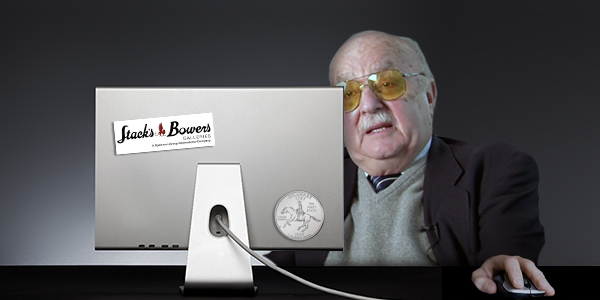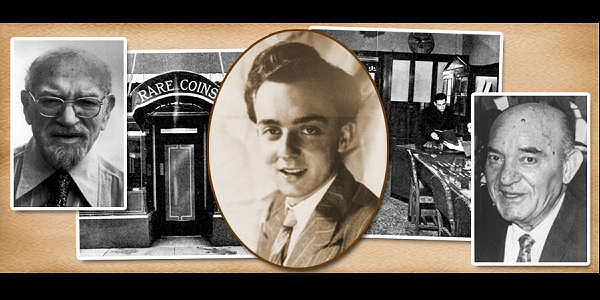
By Harvey Stack – Co-Founder, Stack’s Bowers Galleries ……
Links to earlier parts: 1 | 2 | 3 | 4 | 5 | 6 | 7 | 8 | 9 | 10 | 11
1964 – A Year of Conflicts
The year 1963 was a great year for numismatics as markets seemed to rise, many new collectors entered the market, and (fortunately for the collecting public) many an “Old Time” collection was being offered. Stack’s in 1963 had the good fortune of bringing to market several great collections of “fresh material”.
Several things seemed to happen in 1964. First of all, Congress realized that the silver in our coinage was being bought by the government at almost the market price of Silver. From 1961 to 1963 the price of silver on the open market rose about 20%, and our Mint’s supply was virtually giving away the coins at close to or above the value of the silver in each coin. So Congress decided to stop issuing silver dimes and quarters after 1964, and reduced the amount of silver in the half dollar to 40%.
Of course, even our earlier coins–which were 90% silver for many, many decades–also increased in value.
Those who traded in precious metals started to buy up our basic silver coins and store them away for future sale and possibly melting. This became a great distraction for collecting, and fewer and fewer pre-1964 issues were hoarded. Silver speculators like the famous Hunt Family of Texas, as well as refiners nationwide, invested in the “silver coins” on speculation.
Dealers were flooded with orders to provide silver coins to those who felt the market would be favorable for speculation, and general interest in collecting was deterred by this activity. Even those who had Classic coins in their collection, like circulated Morgan silver dollars, saw that the market for silver might jump enough to increase the value of their collections. So many held back in selling, either by private sale or public auction.
I should mention that the interest in precious metals in coinage was also evident in gold coins during that year. Again, what could be acquired here in the States was aggressively sought after by those who were stymied by the import regulations.

This adverse publicity reduced the auction sales of some current collections. Yes, we had sales almost every month of 1964. but with the exception of a few, most were general collections in all different grades, and collectors still had trouble filling out their want lists.
One of the highlights we had at auction was the “Philip Ward Collection” of United States and foreign Coins, in gold, silver and copper. It was a super collection of world-wide coins, and it served to keep buyers interested for a “real oldtime collection”. Not full of high-price rarities, but it was a basic collection of quality coins from all over the world. So we were able to serve all our customers with the offering. The collection formed by “Irl Baker” was also an outstanding offering of United States gold, silver and copper coins, with some classic rarities among the offering.
Other collections were much smaller, a source for those who needed “space fillers” – and again, our clients had a good source of building on what they had already collected.
The Second factor that influenced the coin business was the tightening of supply by the Treasury’s recently imposed restriction on importing gold coins without a license. This operation was overseen and imposed on gold coin imports by the Office of Gold and Silver Operations (OGSO), which required import licensing for all coins brought into the United States through the Post Office or custom houses. A license was required even for people who bought gold coins overseas and returned with them to the country. The OGSO wanted all imports to be licensed, and the rules and regulations were so oppressive that they greatly slowed the importation of gold coins from overseas.
Problem was, the OGSO never published a list of what would clear customs and what was prohibited. Dealers and collectors were constantly confused and distressed when they tried to acquire gold coins out of the country and bring them here for sale or for their personal collections. It almost seemed like the Office made up the rules as coins were presented to them for licensing – I believe they did!

Of course, these rules and restrictions started to encourage some to smuggle coins into the States, and when someone offered a group of coins, the buyers felt that they had to exercise great care so as not to buy illegally imported gold coins. This only added to the dampening effects of the import restrictions.
Stack’s had the perfect case to test the import regulation. In the late spring of 1964 we were offered, to be sold here, an extensive and specialized collection of world gold coins. We received an itemized list of what it contained and we knew that it was an important collection that we would welcome the opportunity to sell. It consisted of some 900 coins from the 15th century up to the 20th.
We copied the inventory, and I left for the Netherlands in late June 1964 to verify it and tell Norman, who worked with me on the information received, that what we would have to import was readily important for a sale.
I met with the collector in Amsterdam and was very pleased and excited to see how accurate the client was in preparing the list. It had every coin listed, with country, mint of origin if applicable and the coin’s “Robert Freidberg catalogue numbers” also listed (the Friedberg book Gold Coins of the World was and is a wonderful reference book, used to catalog and identify coins by country, design, and series).
So I called Norman, had him file the list for a license, took a short holiday to tour Europe, and waited to hear from Norman that we got the license so I could go back to Amsterdam, supervise the packing of the collection and send it back to New York. Norman advised me that the license never was issued, so we had to delay any shipment. I went home and waited another three weeks. I received some vague responses, but no license.
One of our cataloguers, James C. Risk, was going to go to London for about three weeks on vacation. Jim was a ranking official in Moscow as one of our naval attaches during the second World War. He was assigned to London for a period, before returning to the U.S. and working for Stack’s Coin Galleries. Beside being an expert in foreign coinage, Jim was one of the most informed people about military and national medals given to those who ably served Queen and country. He actually was a friend of Queen Elizabeth II, who requested that he review all the medals, awards, ribbons and memorabilia stored in the Tower of London. He had worked there previously in 1964, and returned to London to finish the job in 1965.
Rather than Norman or me having to make a trip back to Amsterdam, Jim offered to go on our behalfs once we got the import licenses. After a month in London, Jim came home – no license was issued; it was still being worked on by the OGSO in Washington.
The Stack family, all of us who were active at the store on a daily basis, could not understand the delay. So we contacted our lawyers, and had them make a legal demand for the license. The Office replied that they were “still working on it”!
With the advice of our attorney it was recommended that we institute an action against the OGSO for the delay. We decided to proceed, and since I was most familar with the case I became the one who would represent the firm in any action taken. As with all cases where the government is involved, the paper work, and legal actions we were to take, takes a lot of time and the first hearing was in January of 1965.
The client agreed to wait, so we could sell the collection for him.
Meanwhile we conducted our retail business, attended shows around the country, bought some collections, and waited for the license.
Of course we worked with our clients and gave special attention to Josiah K. Lilly, about whom I’ve written extensively. By 1964 he had amassed a collection of close to 5,000 gold coins of the world and a virtually complete set of United States gold coins of all denominations (starting with 1795 to 1932), as well as a great representation of Pioneer and Territorial gold.
Mr. Lilly customarily stopped in to visit on his way to Florida in the late fall and again in the pring when he was returning to Indianapolis. I would visit with him at “Eagle’s Nest“, usually in the late spring and early fall, to deliver his most recent acquisitions and discuss the progress we were making in building a “World Class Gold Coin Collection”.




